How much gas a gas stove consumes: gas flow calculation procedure
Before you buy gas equipment, you can find out its efficiency on your calculator. Read about the effectiveness of the stoves and calculate how much gas the gas stove consumes with standard parameters. Agree, it’s better to sort it out once, and not read the articles one after another. Our article will be extremely useful for you.
There is nothing complicated in physical formulas, if you understand the essence of the issue. We will teach you this. Based on the formulas, it is determined how much fuel the device uses per hour of active action and how well it works in general. We will reveal the technical side of the issue. At the household level, you yourself decide what to do.
Fuel consumption for the same effect on gas stoves varies. Sometimes burners with a double difference in power give the same effect. The stoves have hobs on the hob, and some models are also equipped with gas ovens. In the article we have collected information about the power of burners and gas stoves, which you should pay attention to.
The content of the article:
Methodology for calculating gas consumption
Consumption is calculated based on the total power of all burners gas stove and its various functions. Counting is useful when searching for new equipment, because the difference in fuel consumption between the two models reaches 2-3 times.

The power of the burners (burners) is indicated in the passport to the stove, and it will be issued on demand. In order not to solve the problem of excessive gas consumption, products without a passport should be avoided.
Domestic gas stoves have 2 to 6 burners on the hob and 1-2 in the oven if it also runs on gas. The cooking zones are divided into powerful - large, ordinary - medium and burners with reduced productivity - small. The higher the power, the more fuel the burner consumes. In the instructions for different plates, the concepts of the power level do not coincide.
Average burner parameters:
- power 1 auxiliary (small) burners or the so-called burner performance with auxiliary action - up to 0.6-1 kW;
- power 1 semi-fast (medium) burners - approximately 1.1-2.1 kW, sometimes not less than 1.6 kW;
- power 1 fast (large) burners - approximately 2.1-3.1 kW;
- power 1 burner oven - more than 3 kW for one and from 2 kW for each, if there are two.
The total power used depends on the number of burners lit, the size of the flame and the use of additional features. Usually it is at least 5.5 kW while using all the hobs of the hob and oven.
Useful functions, including lighting for the oven, take away only 15-25 watts. Classic stove It has 4 burners and all on the hob: 2 of normal output and 1 each of high and low.
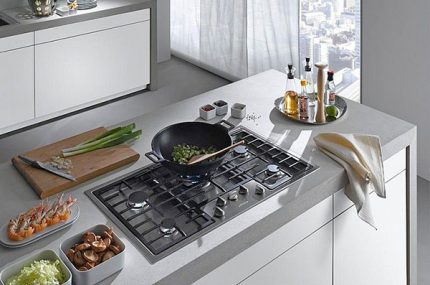
The maximum gas consumption of the stove is determined by the formula V hour = Q / (q × efficiency / 100%)where:
- V hour - maximum gas consumption per hour, m³ / hour;
- Q (also referred to as N, P, S) - the sum of the power indicators for each burner, conditionally - the power of the stove, kW;
- Efficiency (efficiency) - coefficient of positive action,%;
- q - calorific value (specific calorific value) of fuel, kW · h / m³.
The calculation of the maximum power will not cause difficulties, but it will not be possible to determine the approximate monthly flow rate for comparison with the standard or meter indicator. Depending on how much fuel the gas stove consumes and how many kilowatts it produces, for example, an electric kettle, you can compare the costs of heating the water.
The power of the burners is determined by the passport. The calorific value is taken as the average for a particular type of gas that the stove consumes. Calculate the unknown efficiency before buying a plate will not work.
How to determine the efficiency of a gas stove?
It will not be possible to find out the efficiency on a non-working gas stove, and how they take the main indicator of 45% - in the middle between a minimum of 30 and a limit of 60%. In electrical appliances, the coefficient reaches 70–90%.
The efficiency of the gas stove is expressed by the weighted average of the coefficients for each burner. For individual burners, it is 28, 29, 30, 31%, etc., up to a little more than 60%. Usually the more powerful the burner, the higher its efficiency, if we talk about the same stove.
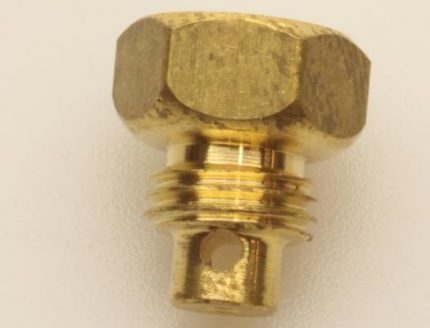
For comparison, the efficiency of a gas boiler is on average about 90%, but the design capacity would have to be overestimated due to heat losses in the housing. In a room with 2 windows and 2 exterior walls - as much as 30%.
The exact efficiency of the plate is calculated by the formula:
ƞ = (Q heating / Q combustion) × 100% = (c × m × ΔT / q × ρ × V) × 100%,
wherein
- ƞ - actually, efficiency,%;
- Q - heat (energy). In the calculation, this value is not needed;
- c - specific heat of water, 4183 J / kg · ° C (also 4183 J / kg · K);
- m - mass of water heated in the kettle, kg;
- ΔT - the difference between the boiling point (+100 ° C) and the initial temperature of the water, ° C. Usually it is 73-79 ° C;
- q - the calorific value of the pipeline gas, usually 33.50 MJ / m³. With the transfer of 33 500 000 J / m³;
- ρ - density of pipeline gas, kg / m³. This is a corridor of 0.68-0.85 kg / m³. A value of 0.8 kg / m³ should be taken if any other is unknown;
- V - the volume of gas consumed during heating the water to a boil, m³. In the calculation, the difference in the gas meter readings is used - before and after. If there is no separate flow meter for the stove, then before you heat the water, you will have to turn off the rest of the gas appliances.
For convenience of calculation, the same unit of temperature is substituted into the specific heat capacity as in the difference for heating water. Only ° C or K is taken, and in both cases a value of 4183 is obtained.

To accurately assess the effectiveness of the pot for heating water should be closed with a lid.
Calculation of the calorific value of the fuel used
Distinguish between higher and lower calorific value. The parameters are determined by the higher (Qв) and lower (Qн) heat (energy) of combustion.
To calculate the actual calorific value, use the formula q = Q / m,
Where:
- q - specific heat of combustion (calorific value), MJ / kg (kW · h / kg, kcal / kg);
- Q - heat of combustion - the amount of heat that is released during the combustion of fuel, MJ (kW · h, kcal);
- m - mass of fuel, kg.
We substitute Qb or Qn in place of Q and we get the calorific value higher and lower, respectively. The final result corresponds to measures MJ / kg, kW · h / kg and kcal / kg (specific calorie content).
In the case of natural gas, “kg” is replaced by “m³”. Knowing the density, you can determine the number of cubic meters per kilogram. Take for this parameter 0.8 kg / m³. The value in kW · h / kg is multiplied by 0.8 and we get the indicator in kW · h / m³. It should be remembered that 1 MJ = 0.278 kW · h = 239 kcal.
The specific heat of combustion of natural gas varies between 8 and 11 kW · h / m³. Usually it is 9.2–9.3 kW · h / m³ - this is the value and is substituted into the very first formula.
For calculations with burner power in kilowatts, the indicated number is taken, and for data with MJ and kcal, the equivalents are used: 33.50 MJ / m³ and 8000 kcal / m³. The values are relevant for the supplied methane G20 (natural gas), with a nominal pressure of up to 20 mbar. The calorific value reaches 50 MJ / m³ for ordinary methane and 41–49 MJ / m³ for natural gas in the bowels.
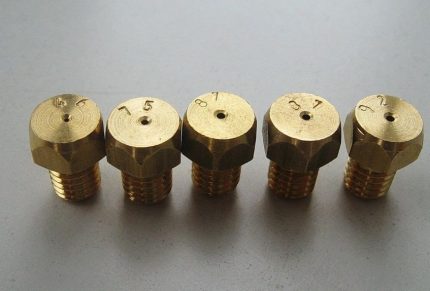
As a calorific value, we take the indicator of the fuel used - natural gas G20 from the pipeline (methane-based mixtures), but the stoves also work from cylinders. The flow rate of liquefied gas in the tables is often measured in kilograms rather than cubic meters, but equivalents can be used for calculations.
Liquefied gas is 1.35 in the "natural". Methane, propane and ethylene in the determination of specific calorific value have coefficients of 1.494, 1.381 and 1.434.
Nuances in calculating the volume of gas
The maximum gas flow per hour shows the consumption of a gas stove, in which each burner worked at full power for 60 minutes in a row. For a day, a stove used by 4 people, on average, consumes about 0.5 cubic meters.
In a month usually it turns out more than 3 and less than 4 m³ per 1 person. In the accounts for apartments without gas meters, indicators on the stove “grow” 3-4 times. This is due to the fact that consumption standards are customized for those who use large volumes of gas.
Different gas consumption maxima have their own meter sizes. The most powerful stoves with an efficiency approaching 30% burn up to 2.5-3 m³ per hour or more with continuous operation at “full speed”. For them, it is better to buy a G2.5 counter. For two powerful plates, the G2.5 or G4 gas meter is enough. For small flowmeters G1.6 are suitable.
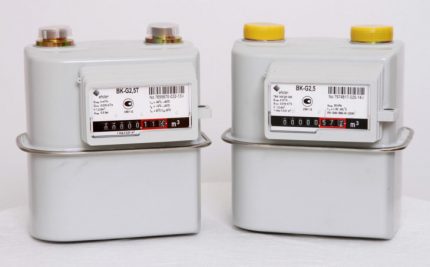
Household gas meters and their ranges
| Index | Lower and upper limits of the range, flow rate in m³ / hour |
| G1.6 | 0,016 — 2,5 |
| G2,5 | 0,025 — 4 |
| G4 | 0,025 — 6; 0,04 — 6 |
| G6 | 0,06 — 8; 0,06 — 10 |
| G8 | 0,08 — 10 |
| G10 | 0,1 — 16 |
| G16 | 0,16 — 25 |
For a stove and a boiler, it does not hurt to have separate counters. It will be more convenient to navigate and make calculations, and the accuracy of the gas meter readings will increase.
Example of calculating gas consumption
Consider the consumption of blue fuel stove Gefest PG 6500-03 0045. The device has 4 burners on the worktop and a gas oven.
Burner power in kilowatts:
- front right - 3.0;
- front left - 1.75-1.8;
- back right - 1.0;
- the back left - 1.75-1.8;
- oven burner - 3.1;
- grill burner - 1.9.
First, round off the performance of medium power burners to 1.8 kW. We summarize the productivity of all six burners: 3.0 + 1.8 + 1.0 + 1.8 + 3.1 + 1.9. We get 12.6 kW.
Efficiency is taken at the level of 45%. We select the specific heat of combustion of domestic gas for two different cases: the usual - 9.3 kW · h / m³ and the maximum - 11 kW · h / m³. In the first calculation we will use the standard one.

We use the formula Q / (q × Efficiency / 100%) = V hour. We get 12.6 kW / (9.3 kW · h / m³ × 45% / 100%) = 3.01 m³ / h.
For complete clarity of calculation, we will do it in 3 stages: 12.6 kW / (9.3 kW · h / m³ × 45% / 100%) = 12.6 m³ / (9.3 hour × 0.45) = 12, 6 m³ / 4.185 hours = 3.01 m³ / hour.
Calculation in steps and only with numbers:
- 12,6 / (9,3 × 45 / 100).
- 12,6 / (9,3 × 0,45).
- 12,6 / 4,185.
- 3,01.
Gefest ПГ 6500-03 0045 is not the most productive stove, but it has 2 burners in the oven right away, so the marginal consumption turned out to be so big.
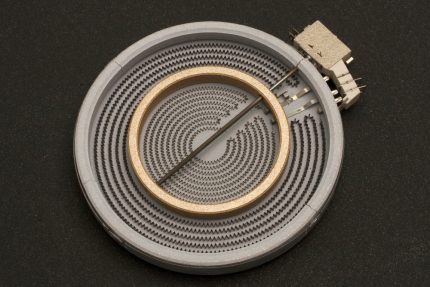
We calculate the fuel consumption with a maximum specific heat of combustion (11 kW · h / m³):
12.6 kW / (11 kW · h / m³ × 45% / 100%) = 2.55 m³ / h.
To make calculations, it is enough to have burner power indicators and know the average values for other parameters.
As you can see, there is nothing complicated in calculating the gas flow rate of a stove. You just need to give it a little time.
We also suggest reading our other article, where we talked in detail about how calculate gas consumption for heating at home.
Conclusions and useful video on the topic
A good example of calculating the cost of heating water with different types of devices:
A way to reduce gas consumption and save time on hob washing:
The gas flow rate and the total power of the burners are directly proportional. If you imagine that the parameters for calculating consumption are average, it will be enough to find out the performance of the burners, and it will become clear how much they save gas.
You can’t do without calculations through the formula if you know the exact efficiency of the model or are going to determine it. After capacity, this is the second important indicator in terms of costs. Cookers with a hob and gas oven have higher fuel consumption, but a gas-fired stove may be better in cooking quality than an electric one with high efficiency.
Write comments on gas stove fuel consumption. Tell us if you measured the level of gas consumption by the stove. If yes, then write why and what it gave you. The contact form is located below.

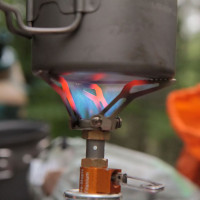 How long is the gas cylinder enough: gas flow calculation for typical gas cylinders
How long is the gas cylinder enough: gas flow calculation for typical gas cylinders 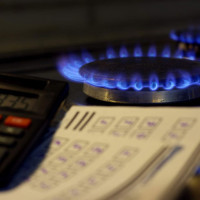 How to determine gas flow: methods for measuring and calculating the fuel used
How to determine gas flow: methods for measuring and calculating the fuel used  How much does it cost to connect gas to a private house: the price of organizing gas supply
How much does it cost to connect gas to a private house: the price of organizing gas supply 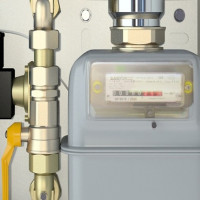 Gas consumption from the gas tank for heating: how to calculate + tips to minimize
Gas consumption from the gas tank for heating: how to calculate + tips to minimize 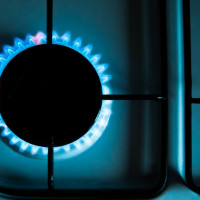 The rate of gas consumption per 1 person per month in a house without a meter: the principle of calculating gas costs
The rate of gas consumption per 1 person per month in a house without a meter: the principle of calculating gas costs 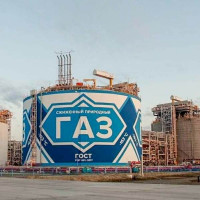 How and why liquefied gas: production technology and scope of use of liquefied gas
How and why liquefied gas: production technology and scope of use of liquefied gas  The best washing machines with dryer: model rating and customer tips
The best washing machines with dryer: model rating and customer tips  What is the color temperature of light and the nuances of choosing the temperature of the lamps to suit your needs
What is the color temperature of light and the nuances of choosing the temperature of the lamps to suit your needs  Replacement of a geyser in an apartment: replacement paperwork + basic norms and requirements
Replacement of a geyser in an apartment: replacement paperwork + basic norms and requirements